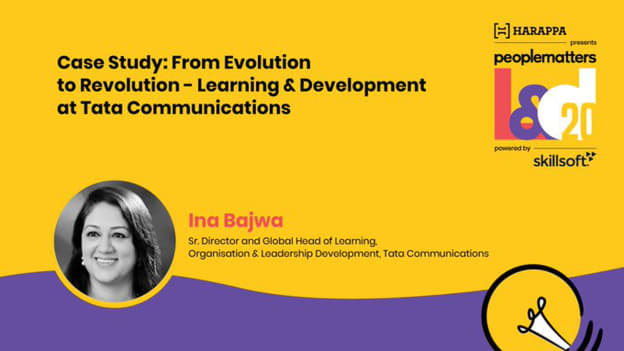The roadmap to becoming a learning organization: Ina Bajwa, Tata Communications

Back in 2015, 90 percent of the learning at Tata Communications took place in classrooms, which was then considered a preferable mode. But by 2018, 91 percent of learning was taking place via digital channels. How was that accomplished? At People Matters L&D Conference 2020, Ina Bajwa, Senior Director and Global Head of L&D at Tata Communications, shared the journey towards becoming an agile learning organization, and the roadmap that worked for them.
Start by aligning L&D objectives with business objectives
In 2014, the L&D team started by introducing MOOCs (Massive Open Online Courses) into the learning environment, as a more efficient alternative to the physical format. "That was a time when digital learning was coming forward, and more and more people were able to access content that took us a very long time to make relevant via the in-person sessions," Bajwa says.
Just putting the technology there was not enough, though. By 2017, the team realized they had to provide employees with better motivators—to use use pull and push approaches to actually nudge people towards learning.
So they initiated a dialogue with employees and leaders, asking them to consider this question: "What skills do you need for the future?"
To the team's surprise, that 'push' approach created a tremendous 'pull' in learners to adopt MOOCs, webinars, and other forms of e-learning for acquiring new skills, to the extent that in just a few years, the trend had been completely reversed: 91 percent of learning was now happening digitally.
The next step was to nudge learners towards the skills that the company needed. So in 2019, Bajwa and her team made certifications into a key metric, because technical skills play a very important role for Tata Communications—she estimates that they form 70-75 percent of the company's learning ecosystem. That same year, they introduced Degreed to personalize and democratize learning, allowing employees to more easily pick up any skill they wanted to learn, and also digitalized about 80 percent of the L&D processes to match the introduction of the learning platform.
Prioritize learner experience and meet their preferences
It was very important to adapt to the changing preferences of employees, Bajwa says. "When they started to experience consumer-grade platforms like Amazon or Netflix in their personal lives, we quickly realized that we can't lag behind in having outdated systems for learning in a digital environment," she points out.
In line with that, the L&D team focused on creating a learner experience based on 'moments of impact' across the learner life cycle. Today, L&D at Tata Communications is bite-sized, any time and anywhere; there is a strong focus on how people are consuming content, what their experience is like, and what feedback they give. The content itself is carefully curated, with a focus on the specific skills that the company needs.
Even career development is closely linked to learning, with skill gaps assessed against where an employee aspires to go, and then recommendations made accordingly.
Moving forward, the team plans to focus on personalizing content and driving targeted skill development, where employees are able to skill across single or multiple domains, and several skill categories. "The learning ecosystem is primarily being driven by the value it generates for the business," Bajwa says.
Define the metrics and measure success
The final step in creating an effective learning system is to measure its success, adjust it and make improvements as needed. Because the L&D team had already built a fully digitized ecosystem, all they needed to do was set up a dashboard where all the pertinent information can be gathered for easy viewing and analysis. For example, the team is able to track how many certifications have been attained during the year—in 2019, Tata Communications employees overachieved the annual target for certifications by 176 percent—and also keep track of how happy people are with their learning.
For 2020, measuring skill readiness has been a key metric for the company. Bajwa and her team identified five skill categories—technical, functional, business, integral, and leadership—and are tracking how proficient employees are in these categories. They are also keeping track of how many people use Tata Communications Learning Academy, the learning platform implemented last year.
"This is our way to ensure that the investments we are making in technology and digital transformation are paying off," Bajwa says.
Finally, and most importantly, the team tracks the 'moments of impact' in the learner experience, and collects feedback from employees on areas such as how well interventions are working, how useful platforms are, whether they have sufficient support, what they want to see more or less of. That collated feedback is then put to use in improving the learning ecosystem.












